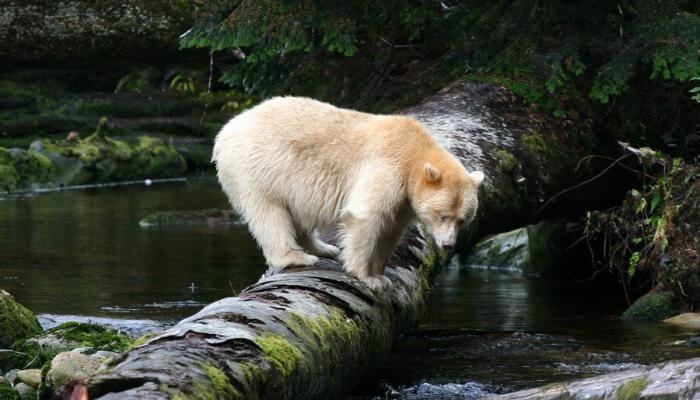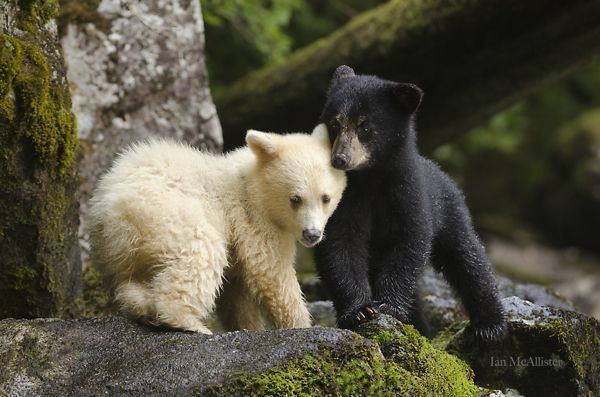Genus Ursus Rank Subspecies Phylum Chordata | Family Ursidae Scientific name Ursus americanus kermodei Order Carnivores | |
 | ||
Similar Bear, American black bear, Kodiak bear, Bears, Spectacled bear | ||
Spirit bear kermode bear catching and eating salmon
The Kermode bear (Ursus americanus kermodei), also known as the "spirit bear" (particularly in British Columbia), is a rare subspecies of the American black bear living in the Central and North Coast regions of British Columbia, Canada. It is the official provincial mammal of British Columbia. It is noted for about one-tenth of its population having white or cream-coloured coats like polar bears. This colour is due to a double recessive gene unique in the subspecies. They are not albinos and not any more related to polar bears or the "blonde" brown bears of Alaska's "ABC Islands" than other members of their species. Sometimes, a mother black bear can have a white cub.
Contents
- Spirit bear kermode bear catching and eating salmon
- Description
- Habitat
- Kermode bears in captivity
- References
Description

Spirit bears hold a prominent place in the oral traditions of the indigenous peoples of the area. They have also been featured in a National Geographic documentary. Scientists have found that black bears are not as effective at catching fish as white bears, as the white bears are less visible from the perspective of the fish. At night, the two colours of bears have similar success rates at catching fish, such as salmon, but during the day, the white bears are 30 percent more effective.

The Kermode bear was named after Frank Kermode, former director of the Royal B.C. Museum, who researched the subspecies and was a colleague of William Hornaday, the zoologist who described it. A common mispronunciation of Kermode as /kərˈmoʊdiː/ kər-MOH-dee differs from the actual pronunciation of the Kermode surname, which originates on the Isle of Man and is properly pronounced /ˈkɜːrmoʊd/ KUR-mohd, which is the usual way to pronounce Kermode bear. In the Isle of Man the name is pronounced /kərˈmoʊd/ kur-MOHD.
Habitat
The U. a. kermodei subspecies ranges from Princess Royal Island to Prince Rupert, British Columbia, on the coast, and inland toward Hazelton, British Columbia. It is known in the Tsimshianic languages as moksgm'ol. In the February 2006 Speech from the Throne by the Government of British Columbia, the Lieutenant Governor announced the government's intention to designate the Kermode, or spirit bear, as British Columbia's official animal. It was adopted as such in April of that year. A male Kermode bear can reach 225 kilograms (496 lb) or more, females are much smaller with a maximum weight of 135 kg (298 lb). Straight up, it stands 180 cm (71 in) tall.

Fewer than 400 Kermode bears are estimated to exist in the coast area that stretches from Southeast Alaska southwards to the northern tip of Vancouver Island; about 120 inhabit the large Princess and Prince Royal Island. The largest concentration of the white bears inhabits 80-square-mile (210 km2) Gribbell Island, in the territory of the Gitga'ata people.

The bear's habitat is potentially under threat from the Enbridge Northern Gateway Pipelines, whose planned route passes near the Great Bear Rainforest. Native groups including the Gitga'at have opposed the pipeline.
Kermode bears in captivity

In October 2012, it was announced that a Kermode bear would be housed at the British Columbia Wildlife Park in Kamloops, BC, believed to be the only such recessive gene from a subspecies bear in captivity. The yearling cub was found abandoned in northwestern British Columbia on the side of Terrace Mountain near Terrace. After two unsuccessful attempts to rehabilitate and release him back into the wild, the cub, now nicknamed 'Clover' by handlers, was sent to the park when conservation officers decided that he was not a candidate for relocation. The park has plans to create a custom home for the bear, who has escaped from his temporary enclosure once already. Animal rights group Lifeforce believes that the bear is healthy enough to survive on his own and that he should be relocated and released back into the wild. Provincial government wildlife officials have maintained its position against attempting a long-distance relocation, stating that the risks outweigh the possible benefits, and as of October 2015, the bear remained in captivity.
